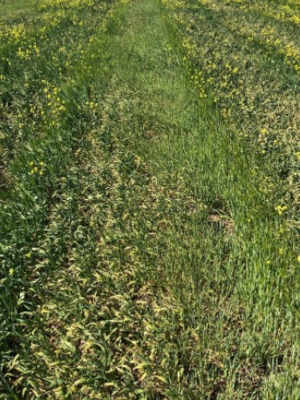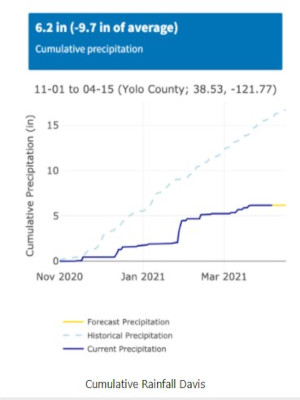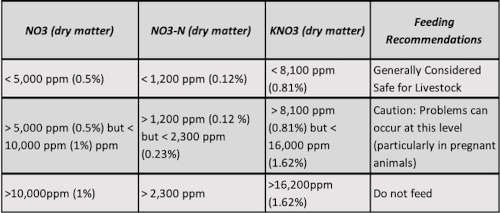By Konrad Mathesius and Gabriele Maier et.al
Looking a little dry out there?
Dry conditions mean it's good to be cautious about nitrate toxicity in forage crops, particularly small grain hay, grasses, and anything weedy! Nitrates can harm or even kill animals. Growers should test forages and stay vigilant.

Drought Stressed Barley
Why are dry years more of a concern for nitrate toxicity?
Drought conditions in California this year are the worst they've been in decades. Many growers are considering cutting their grain fields for hay, however, that may cause some concerns for ruminant livestock if forage nitrate (NO3) levels are not monitored closely since drought stress can cause nitrate accumulation in forage plants.
Rainfall patterns like those we've seen this year can lead to excessive nitrate levels in forage, particularly if moderately high rates of nitrogen fertilizer were applied either pre-plant or in-season. In normal conditions crops would accumulate high levels of nitrate until heading, but then much of the nitrate would be metabolized as the plant converted nitrate into amino acids and proteins for grain fill. Without moisture, however, plant metabolism slows, which means these nitrates may still be lingering in the stem.
Severe drought conditions are a problem even under lower fertilization rates. In a drought year such as the one we're seeing now, the metabolic process is much slower as plants struggle to find water in the soil profile. Plants will also react to drought stress by reducing the number of reproductive tillers, spikes (seed heads), or seeds on the spike/ panicle, meaning that even if the plant makes it to maturity, nitrate levels may still be higher than normal.
Which forages are most susceptible? The inverse relationship between nitrate accumulation and water availability makes dryland hays more susceptible to high levels of nitrate. Growers with hay on irrigated ground may consider an early irrigation to not only boost yield, but alleviate nitrate concerns. If irrigation is not an option, testing forage specifically for nitrates is an easy way to assess risk. Buyers should consider testing hay in advance of feeding to make it possible to mitigate feed concentrations accordingly if higher than normal nitrate levels exist.

Nitrate accumulation is more of an issue in some hays than others. Sorghum species (such as Sudan grass) are particularly prone to high nitrate accumulation, but even crops such as oats, barley, and wheat can have excessively high nitrate concentrations in normal years, let alone drought years such as this.
Weeds are especially problematic.
Weedy fields also tend to have much higher levels of nitrate. Weeds such as lambsquarters and pigweed are famous nitrate accumulators, and over the years, we have seen cattle killed when grazing these weedy plants, or when they are fed greenchop. Grassy weeds, especially if stressed can accumulate nitrates.
Typically, alfalfa hay and corn (after being ensilaged) don't run as high a risk of high nitrates even with high levels of fertilization, but high weed populations in those fields can still cause nitrate issues for ruminants. However, any crop can accumulate nitrates that threaten livestock.
When in doubt, test for nitrates. Different crops, soil types, fertilizer sources, and methods of application can lead to variability in nitrate accumulation. Testing hay and forage for nitrates is the only way to ascertain if a problem really exists, but keep in mind that forage concentrations are variable, so proper sampling is important. Clip at least 20 representative plants at grazing height, cut them into 2 to 3 inch pieces and mix thoroughly. Samples must be shipped soon after collection for accurate results, but because nitrate levels can decrease in transit, samples should be placed in plastic bags and stored on ice. If shipping, samples should be frozen for 24 hours prior to shipping. This will help reduce the chances of nitrate reduction from bacteria or lingering metabolic processes. [1] Also, ship in an insulated container.
Remember: Labs will report results in different units. Nitrate concentrations in test results can be reported as total nitrate (NO3), nitrate nitrogen (NO3-N), or potassium nitrate (KNO3). Table 1 can help interpret results from a plant nitrate test.
Test Thresholds for Nitrate in Different Reporting Units, Dry Basis

Table 1: Interpreting nitrate (differing reporting units) forage tests.[2] Wet basis results are rare, but have different thresholds from dry basis results; pay close attention to the details of your report.
What else can growers and livestock managers do?
Aside from testing, growers that suspect their hay may be high in nitrate can:
- Delay harvest until several weeks after the next substantial rain even, if there is sufficient rain, the plant will be able to convert more nitrate into tissue, potentially lowering overall nitrate concentrations.
- For small grains, delay harvest until soft dough. Nitrate levels are highest around heading and reduce as the plant matures (because it is converting nitrate to protein in the seed head).
- Avoid additional N fertilizer applications this year since it is likely that there is sufficient soil nitrate at this point and water will be the limiting factor for most hay acreage. In future years space out fertilization events that will allow for more precise adjustment of nitrate inputs to seasonal conditions
- Field Test. Consider using a nitrogen-rich reference strip in conjunction with split fertilizer applications in future plantings, this will allow you to better manage your grain yields, and will help prevent excess fertilizer applications. If you have to cut your field for feed, the hay will be less likely to have excessive fertilizer.
- Cut forages higher above the ground (nitrates tend to accumulate in the lower stem)
- Harvest for silage instead of green chop (proper fermentation can reduce nitrate levels)
- Dilute Feeds. Feed high-nitrate feeds with low-nitrate feed, although in some cases such as pregnant cows, feeding above 1.5% total nitrate concentration should be avoided altogether.
- Water Test. Nitrates in water can be a problem too. Test the water, and feed a balanced ration and provide low nitrate water at all times
- Adapt to high-nitrate Feeds. Slowly increase the nitrate levels of feed, cattle have some capacity for adaptation so long as nitrate levels in the field are below 0.9%. Cattle should not graze in pasture where nitrate levels are above 0.9%.
- Don't graze hungry. Feed cows before turning them out to pasture to avoid over-consumption until acclimated.
- Do not under-stock pasture (grazers generally prefer more succulent leaves and will naturally avoid stems where nitrate concentrations are higher unless there is pressure to eat)
- Observe Animals. Keep an eye out for signs in grazers[3]
What to look for in Livestock?
Due to the chemistry of the rumen, nitrates systematically convert to nitrite in ruminant stomachs. Normally nitrite converts to ammonia and then to protein at a steady pace, but if the rumen receives more nitrate than can be converted in the rumen, the nitrite begins to build up and starts binding with hemoglobin in red blood cells (thereby blocking oxygen). This essentially reduces the capacity of the animal's circulatory system to transport oxygen to cells. At normal levels the body has ways of dealing with this, but at higher levels the animal's blood becomes progressively unable to transport oxygen. As a result, blood often appears brownish, and animals begin to exhibit signs of exhaustion (much the same as one might expect if the body were demanding more oxygen than the heart and lungs could provide).
If you think your livestock may have consumed feed with toxic levels of nitrate, keep an eye out for signs of nitrate toxicity. Signs include: rapid/ difficult breathing, chocolate brown blood, staggering, tremors, salivation, weakness, coma, or a rapid pulse.[4] Ideally though, careful sampling and testing of feed followed by a careful analysis of results can prevent livestock from consuming toxic levels of nitrate in the first place.
While drought conditions are not guaranteed to cause excess nitrates in feed, they do elevate the probability of that occurring. Growers and livestock managers should remain vigilant and test!
Source : ucanr.edu